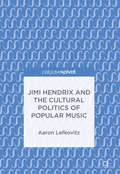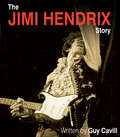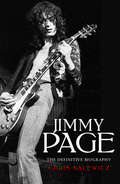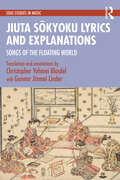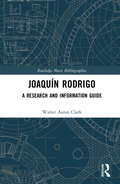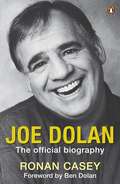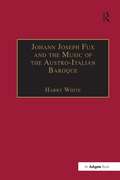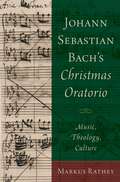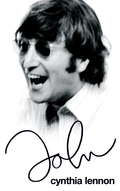- Table View
- List View
Jimi Hendrix and the Cultural Politics of Popular Music
by Aaron LefkovitzThis book, on Jimi Hendrix’s life, times, visual-cultural prominence, and popular music, with a particular emphasis on Hendrix’s relationships to the cultural politics of race, gender, sexuality, ethnicity, class, and nation. Hendrix, an itinerant “Gypsy” and “Voodoo child” whose racialized “freak” visual image continues to internationally circulate, exploited the exoticism of his race, gender, and sexuality and Gypsy and Voodoo transnational political cultures and religion. Aaron E. Lefkovitz argues that Hendrix can be located in a legacy of black-transnational popular musicians, from Chuck Berry to the hip hop duo Outkast, confirming while subverting established white supremacist and hetero-normative codes and conventions. Focusing on Hendrix’s transnational biography and centrality to US and international visual cultural and popular music histories, this book links Hendrix to traditions of blackface minstrelsy, international freak show spectacles, black popular music’s global circulation, and visual-cultural racial, gender, and sexual stereotypes, while noting Hendrix’s place in 1960s countercultural, US-exceptionalist, cultural Cold War, and rock histories.
Jimi Hendrix and the Cultural Politics of Popular Music
by Aaron LefkovitzThis book, on Jimi Hendrix’s life, times, visual-cultural prominence, and popular music, with a particular emphasis on Hendrix’s relationships to the cultural politics of race, gender, sexuality, ethnicity, class, and nation. Hendrix, an itinerant “Gypsy” and “Voodoo child” whose racialized “freak” visual image continues to internationally circulate, exploited the exoticism of his race, gender, and sexuality and Gypsy and Voodoo transnational political cultures and religion. Aaron E. Lefkovitz argues that Hendrix can be located in a legacy of black-transnational popular musicians, from Chuck Berry to the hip hop duo Outkast, confirming while subverting established white supremacist and hetero-normative codes and conventions. Focusing on Hendrix’s transnational biography and centrality to US and international visual cultural and popular music histories, this book links Hendrix to traditions of blackface minstrelsy, international freak show spectacles, black popular music’s global circulation, and visual-cultural racial, gender, and sexual stereotypes, while noting Hendrix’s place in 1960s countercultural, US-exceptionalist, cultural Cold War, and rock histories.
Jimi Hendrix Story
by Guy CavillJimi Hendrix is regarded by many to have been the greatest of all rock guitarists. The 40th anniversary of his death on the 18th October reminded us all that in all these years no other guitarist has come along in the way that Hendrix had to defy musical conventions and to question how we listen to music. His recordings continue to sell. In America alone the amount is estimated to be somewhere in the region of twenty million. As a mark of their high regard two of his albums, Are you Experienced and Electric Ladyland, have been inducted into the Grammy Hall of Fame. The DVD Book of Hendrix looks at the guitarist's life and tries to answer why it is that Hendrix was so important, and just why his death at the age of 27 was felt so keenly by so many around the world. Though his life was tragically short, it is hard to imagine how he could have lived a fuller one.
Jimmy Page: The Definitive Biography
by Chris SalewiczFounder of one of the most influential and successful rock bands of all time, legendary Led Zeppelin guitarist Jimmy Page has nevertheless remained an enigma. In this definitive and comprehensive biography of his life so far, Chris Salewicz draws on his own interviews with Page and those closest around him to unravel the man behind the mystery.
Jiuta Sōkyoku Lyrics and Explanations: Songs of the Floating World (ISSN)
by Christopher Yohmei Blasdel Gunnar Jinmei LinderJiuta Sōkyoku Lyrics and Explanations is a compendium of seventy-three representative songs from the well-known genre of traditional Japanese Edo-period sankyoku ensemble music.Including extensive annotations along with commentaries and notes on their musical and performative aspects, the collection begins with an overview which traces the history of the jiuta sōkyoku genre and the various socio-political influences at work in its formation. The translations and analyses are followed by a substantive glossary and bibliography, allowing for a deeper understanding of both the literary and musical aspects of jiuta sōkyoku compositions.Jiuta Sōkyoku Lyrics and Explanations is a comprehensive anthology that will be of great interest to researchers, including ethnomusicologists, Japanese studies scholars and poetry lovers who are fascinated with the literary and musical impact of the Edo period.
Jiuta Sōkyoku Lyrics and Explanations: Songs of the Floating World (ISSN)
Jiuta Sōkyoku Lyrics and Explanations is a compendium of seventy-three representative songs from the well-known genre of traditional Japanese Edo-period sankyoku ensemble music.Including extensive annotations along with commentaries and notes on their musical and performative aspects, the collection begins with an overview which traces the history of the jiuta sōkyoku genre and the various socio-political influences at work in its formation. The translations and analyses are followed by a substantive glossary and bibliography, allowing for a deeper understanding of both the literary and musical aspects of jiuta sōkyoku compositions.Jiuta Sōkyoku Lyrics and Explanations is a comprehensive anthology that will be of great interest to researchers, including ethnomusicologists, Japanese studies scholars and poetry lovers who are fascinated with the literary and musical impact of the Edo period.
João Gilberto and Stan Getz's Getz/Gilberto (33 1/3 Brazil Ser.)
by Bryan Daniel McCannMost die-hard Brazilian music fans would argue that Getz/Gilberto, the iconic 1964 album featuring "The Girl from Ipanema," is not the best bossa nova record. Yet we've all heard "The Girl from Ipanema" as background music in a thousand anodyne settings, from cocktail parties to telephone hold music. So how did Getz/Gilberto become the Brazilian album known around the world, crossing generational and demographic divides? Bryan McCann traces the history and making of Getz/Gilberto as a musical collaboration between leading figure of bossa nova João Gilberto and Philadelphia-born and New York-raised cool jazz artist Stan Getz. McCann also reveals the contributions of the less-understood participants (Astrud Gilberto's unrehearsed, English-language vocals; Creed Taylor's immaculate production; Olga Albizu's arresting, abstract-expressionist cover art) to show how a perfect balance of talents led to not just a great album, but a global pop sensation. And he explains how Getz/Gilberto emerged from the context of Bossa Nova Rio de Janeiro, the brief period when the subtle harmonies and aching melodies of bossa nova seemed to distill the spirit of a modernizing, sensuous city.33 1/3 Global, a series related to but independent from 33 1/3, takes the format of the original series of short, music-based books and brings the focus to music throughout the world. With initial volumes focusing on Japanese and Brazilian music, the series will also include volumes on the popular music of Australia/Oceania, Europe, Africa, the Middle East, and more.
João Gilberto and Stan Getz's Getz/Gilberto: Holy Places In Louisiana (33 1/3 Brazil Ser.)
by Bryan Daniel McCannMost die-hard Brazilian music fans would argue that Getz/Gilberto, the iconic 1964 album featuring "The Girl from Ipanema," is not the best bossa nova record. Yet we've all heard "The Girl from Ipanema" as background music in a thousand anodyne settings, from cocktail parties to telephone hold music. So how did Getz/Gilberto become the Brazilian album known around the world, crossing generational and demographic divides? Bryan McCann traces the history and making of Getz/Gilberto as a musical collaboration between leading figure of bossa nova João Gilberto and Philadelphia-born and New York-raised cool jazz artist Stan Getz. McCann also reveals the contributions of the less-understood participants (Astrud Gilberto's unrehearsed, English-language vocals; Creed Taylor's immaculate production; Olga Albizu's arresting, abstract-expressionist cover art) to show how a perfect balance of talents led to not just a great album, but a global pop sensation. And he explains how Getz/Gilberto emerged from the context of Bossa Nova Rio de Janeiro, the brief period when the subtle harmonies and aching melodies of bossa nova seemed to distill the spirit of a modernizing, sensuous city.33 1/3 Global, a series related to but independent from 33 1/3, takes the format of the original series of short, music-based books and brings the focus to music throughout the world. With initial volumes focusing on Japanese and Brazilian music, the series will also include volumes on the popular music of Australia/Oceania, Europe, Africa, the Middle East, and more.
Joaquín Rodrigo: Writings on Music
by Raymond Calcraft Elizabeth MatthewsJoaquín Rodrigo, Spain's leading composer of the second half of the twentieth century, was also a writer of considerable distinction. In addition to his 170 compositions in almost every musical form, including the world-famous Concierto de Aranjuez for guitar and orchestra, he published articles and critical reviews throughout his working life. This volume makes available Rodrigo's writings to English-speaking readers throughout the world. The generous selection reveals an outstanding critical mind, equally illuminating on the main developments in the history of classical music and its most important composers, from Bach and Mozart to Verdi and Puccini, as well as Rodrigo's contemporaries. Rodrigo’s writings also cover many aspects of the culture and music of Spain and the country's major composers, as well as being an invaluable guide to an understanding and appreciation of Rodrigo's own works. The composer's style of writing is extremely varied, by turns incisive, eloquent, poetic, or delightfully humorous. Given the worldwide fame and popularity of his music, the availability in English of a large number of the composer's many articles and critical reviews will be of the greatest interest to musicians, scholars, music critics, and music-lovers alike.
Joaquín Rodrigo: Writings on Music
by Raymond Calcraft Elizabeth MatthewsJoaquín Rodrigo, Spain's leading composer of the second half of the twentieth century, was also a writer of considerable distinction. In addition to his 170 compositions in almost every musical form, including the world-famous Concierto de Aranjuez for guitar and orchestra, he published articles and critical reviews throughout his working life. This volume makes available Rodrigo's writings to English-speaking readers throughout the world. The generous selection reveals an outstanding critical mind, equally illuminating on the main developments in the history of classical music and its most important composers, from Bach and Mozart to Verdi and Puccini, as well as Rodrigo's contemporaries. Rodrigo’s writings also cover many aspects of the culture and music of Spain and the country's major composers, as well as being an invaluable guide to an understanding and appreciation of Rodrigo's own works. The composer's style of writing is extremely varied, by turns incisive, eloquent, poetic, or delightfully humorous. Given the worldwide fame and popularity of his music, the availability in English of a large number of the composer's many articles and critical reviews will be of the greatest interest to musicians, scholars, music critics, and music-lovers alike.
Joaquín Rodrigo: A Research and Information Guide (Routledge Music Bibliographies)
by Walter Aaron ClarkJoaquín Rodrigo: A Research and Information Guide catalogues and summarizes the musical works and related literature of Joaquín Rodrigo (1901–99), perhaps the most important Spanish composer of concert music in the second half of the twentieth century. The guide provides annotated bibliographic entries for both primary and secondary sources, detailing several guitar concertos, concertos for flute, violin, harp, cello, and piano, as well as symphonic pieces, piano solos, chamber music, and choral and stage works. Rodrigo’s reputation rests on the Concierto de Aranjuez for guitar and orchestra and its expressive middle movement, which inspired jazz arrangements by Miles Davis and Chick Corea in the 1960s and continues to appear in film scores even eighty years after its composition. A major reference tool for all those interested in the prolific Rodrigo and his music—featuring a chronology of the composer’s life and robust indices that enable researchers to easily locate sources by author, composition, or subject—Joaquín Rodrigo: A Research and Information Guide is a valuable resource for students and researchers alike.
Joaquín Rodrigo: A Research and Information Guide (Routledge Music Bibliographies)
by Walter Aaron ClarkJoaquín Rodrigo: A Research and Information Guide catalogues and summarizes the musical works and related literature of Joaquín Rodrigo (1901–99), perhaps the most important Spanish composer of concert music in the second half of the twentieth century. The guide provides annotated bibliographic entries for both primary and secondary sources, detailing several guitar concertos, concertos for flute, violin, harp, cello, and piano, as well as symphonic pieces, piano solos, chamber music, and choral and stage works. Rodrigo’s reputation rests on the Concierto de Aranjuez for guitar and orchestra and its expressive middle movement, which inspired jazz arrangements by Miles Davis and Chick Corea in the 1960s and continues to appear in film scores even eighty years after its composition. A major reference tool for all those interested in the prolific Rodrigo and his music—featuring a chronology of the composer’s life and robust indices that enable researchers to easily locate sources by author, composition, or subject—Joaquín Rodrigo: A Research and Information Guide is a valuable resource for students and researchers alike.
Joe Dolan: The Official Biography
by Ronan CaseyGrowing up in poor circumstances in the midlands town of Mullingar might seem an unlikely start for a musical superstar, but that's exactly the journey Joe Dolan travelled in his amazing life. Not only that, Joe never forgot his roots and loved Mullingar to the day he died.From losing his father at a tragically young age, to his bold decision while still a teenager to throw in a good job and pursue his dream of playing music for a living, to early stardom with The Drifters and conquering the USSR, to his later re-emergence for a new generation of fans as the iconic Man in the White Suit - the amazing, mad, bad and funny stories behind the legendary career will be told for the first time.It is a colourful, life-affirming, revealing and hugely entertaining biography that is a fitting tribute to such a beloved performer.
Joe Hisaishi's Soundtrack for My Neighbor Totoro (33 1/3 Japan)
by Kunio HaraMy Neighbor Totoro is a long-standing international icon of Japanese pop culture that grew out of the partnership between the legendary animator Miyazaki Hayao and the world-renowned composer Joe Hisaishi. A crucial step in the two artists' collaboration was the creation of the album, My Neighbor Totoro: Image Song Collection, with lyrics penned by Miyazaki and Nakagawa Rieko, a famed children's book author, and music composed by Hisaishi. The album, released in 1987 prior to the opening of the film, served not only as a promotional product, but also provided Miyazaki with concrete ideas about the characters and the themes of the film. This book investigates the extent to which Hisaishi's music shaped Miyazaki's vision by examining the relationship between the images created by Miyazaki and the music composed by Hisaishi, with special emphasis on their approaches to nostalgia, one of the central themes of the film.
Joe Hisaishi's Soundtrack for My Neighbor Totoro (33 1/3 Japan)
by Kunio HaraMy Neighbor Totoro is a long-standing international icon of Japanese pop culture that grew out of the partnership between the legendary animator Miyazaki Hayao and the world-renowned composer Joe Hisaishi. A crucial step in the two artists' collaboration was the creation of the album, My Neighbor Totoro: Image Song Collection, with lyrics penned by Miyazaki and Nakagawa Rieko, a famed children's book author, and music composed by Hisaishi. The album, released in 1987 prior to the opening of the film, served not only as a promotional product, but also provided Miyazaki with concrete ideas about the characters and the themes of the film. This book investigates the extent to which Hisaishi's music shaped Miyazaki's vision by examining the relationship between the images created by Miyazaki and the music composed by Hisaishi, with special emphasis on their approaches to nostalgia, one of the central themes of the film.
Johann Joseph Fux and the Music of the Austro-Italian Baroque
by Harry WhiteJohann Joseph Fux's reputation as a theorist and the long-term influence of his theoretical and pedagogical work have ensured that his name is widely known in music circles in the West. His pre-eminence as the foremost native-born composer of the Austrian Baroque has resulted in attention being focused on his work as an exemplum of virtually every genre, sacred or secular of Austro-Italian early eighteenth-century music. The publication of the Fux Gesamtausgabe has greatly enhanced the reputation of his music and the essays in this volume will develop our understanding of Fux, his music, and his place in musical history.
Johann Joseph Fux and the Music of the Austro-Italian Baroque
by Harry WhiteJohann Joseph Fux's reputation as a theorist and the long-term influence of his theoretical and pedagogical work have ensured that his name is widely known in music circles in the West. His pre-eminence as the foremost native-born composer of the Austrian Baroque has resulted in attention being focused on his work as an exemplum of virtually every genre, sacred or secular of Austro-Italian early eighteenth-century music. The publication of the Fux Gesamtausgabe has greatly enhanced the reputation of his music and the essays in this volume will develop our understanding of Fux, his music, and his place in musical history.
Johann Mattheson's Pièces de clavecin and Das neu-eröffnete Orchestre: Mattheson's Universal Style in Theory and Practice
by Margaret SearesA prolific music theorist and critic as well as an established composer, Johannes Mattheson remains surprisingly understudied. In this important study, Margaret Seares places Mattheson‘s Pi‘s de clavecin (1714) in the context of his work as a public intellectual who encouraged German musicians and their musical public to eschew what he saw as the hidebound traditions of the past, and instead embrace a universalism of style and expression derived from contemporary currents in music of the leading European nations. Beginning with the early non-musical writings by Mattheson, Seares places them in the context of the cosmopolitan city-state of Hamburg, before moving to a detailed study of his first major musical treatise Das neu-er ffnete Orchestre of 1713, in which he espoused his views about the musics of the past and present and, in particular, the characteristics of the musics of Germany, Italy, France and England. This latter section of the treatise, Part III, is edited and translated into English in the book's appendix - the first such translation available. Seares then moves on to an evaluation of the Pi‘s de clavecin as a work in which Mattheson reflects in musical terms the themes of modernism (in the sense ofa mode) and universalism that are such a strong part of his writings of the period, and a work that represents an important precursor for the keyboard suites of Johann Sebastian Bach and Georg Frideric Handel.
Johann Mattheson's Pièces de clavecin and Das neu-eröffnete Orchestre: Mattheson's Universal Style in Theory and Practice
by Margaret SearesA prolific music theorist and critic as well as an established composer, Johannes Mattheson remains surprisingly understudied. In this important study, Margaret Seares places Mattheson‘s Pi‘s de clavecin (1714) in the context of his work as a public intellectual who encouraged German musicians and their musical public to eschew what he saw as the hidebound traditions of the past, and instead embrace a universalism of style and expression derived from contemporary currents in music of the leading European nations. Beginning with the early non-musical writings by Mattheson, Seares places them in the context of the cosmopolitan city-state of Hamburg, before moving to a detailed study of his first major musical treatise Das neu-er ffnete Orchestre of 1713, in which he espoused his views about the musics of the past and present and, in particular, the characteristics of the musics of Germany, Italy, France and England. This latter section of the treatise, Part III, is edited and translated into English in the book's appendix - the first such translation available. Seares then moves on to an evaluation of the Pi‘s de clavecin as a work in which Mattheson reflects in musical terms the themes of modernism (in the sense ofa mode) and universalism that are such a strong part of his writings of the period, and a work that represents an important precursor for the keyboard suites of Johann Sebastian Bach and Georg Frideric Handel.
Johann Sebastian Bach's Christmas Oratorio: Music, Theology, Culture
by Markus RatheyIn the last decades of the 17th century, the feast of Christmas in Lutheran Germany underwent a major transformation when theologians and local governments waged an early modern "war on Christmas," discouraging riotous pageants and carnivalesque rituals in favor of more personal and internalized expressions of piety. Christmas rituals, such as the "Heilig Christ" plays and the rocking of the child (Kindelwiegen) were abolished, and Christian devotion focused increasingly on the metaphor of a birth of Christ in the human heart. John Sebastian Bach's Christmas Oratorio, composed in 1734, both reflects this new piety and conveys the composer's experience living through this tumult during his own childhood and early career. Markus Rathey's book is the first thorough study of this popular masterpiece in English. While giving a comprehensive overview of the Christmas Oratorio as a whole, the book focuses on two themes in particular: the cultural and theological understanding of Christmas in Bach's time and the compositional process that led Bach from the earliest concepts to the completed piece. The cultural and religious context of the oratorio provides the backdrop for Rathey's detailed analysis of the composition, in which he explores Bach's compositional practices, for example, his reuse and parodies of movements that had originally been composed for secular cantatas. The book analyzes Bach's original score and sheds new light on the way Bach wrote the piece, how he shaped musical themes, and how he revised his initial ideas into the final composition.
Johann Sebastian Bach's Christmas Oratorio: Music, Theology, Culture
by Markus RatheyIn the last decades of the 17th century, the feast of Christmas in Lutheran Germany underwent a major transformation when theologians and local governments waged an early modern "war on Christmas," discouraging riotous pageants and carnivalesque rituals in favor of more personal and internalized expressions of piety. Christmas rituals, such as the "Heilig Christ" plays and the rocking of the child (Kindelwiegen) were abolished, and Christian devotion focused increasingly on the metaphor of a birth of Christ in the human heart. John Sebastian Bach's Christmas Oratorio, composed in 1734, both reflects this new piety and conveys the composer's experience living through this tumult during his own childhood and early career. Markus Rathey's book is the first thorough study of this popular masterpiece in English. While giving a comprehensive overview of the Christmas Oratorio as a whole, the book focuses on two themes in particular: the cultural and theological understanding of Christmas in Bach's time and the compositional process that led Bach from the earliest concepts to the completed piece. The cultural and religious context of the oratorio provides the backdrop for Rathey's detailed analysis of the composition, in which he explores Bach's compositional practices, for example, his reuse and parodies of movements that had originally been composed for secular cantatas. The book analyzes Bach's original score and sheds new light on the way Bach wrote the piece, how he shaped musical themes, and how he revised his initial ideas into the final composition.
Johann Sebastian Bach's Goldberg Variations Reimagined
by Erinn E. KnytThis book provides the first detailed reception history of adaptations of Johann Sebastian Bach's Aria mit 30 Ver?nderungen (Goldberg Variations, BWV 988). It documents multiple ways Bach's work has appeared in arrangements, transcriptions, and re-compositions from 1800 to 2020. It examines adaptations for the traditional concert hall as well as for dance, theater, cinema, literature, digital media, and visual art. Overall, the book reveals a dramatic increase in adaptations of the piece in the late twentieth and early twenty-first centuries. In addition, it brings the reception history of Bach's Goldberg Variations into dialogue with broader scholarly discourse about performance practice issues. The piece was often performed in transcribed or arranged versions in the nineteenth century and then again in the late twentieth and early twenty-first centuries. Yet if nineteenth-century adaptations of this piece were usually created out of necessity, as a means of performing a lengthy piece without access to the original instrument, many twenty-first century adaptations, which have developed alongside historically informed performances, were motivated by deconstructionist ideologies. This contrasts with the middle part of the twentieth century, when there was a prevalence of historically informed performances and a dearth of adaptations. Comparisons to other works by Bach reveal similar performance practice trends. The reception history documented in the book also considers the musical work concept. It shows that, particularly since the late 1980s, there has been a loosening of the regulative hold of the modernist work concept associated with single authorship, structural unity, and an autonomous score. It reveals that many recent adaptations are not direct interpretations of an authoritative text, but engage in multivalent dialogues as Bach's score becomes an infinite or open text in which multiple people, including subsequent (re)-composers, performers, directors, and audience members enter into inter- and intra-textual conversations. In the process, the book contributes to recent studies about adaptations, the role of musical authorship, and changing notions of Bach and the work concept in the twenty-first century. At the same time, it discusses many recently composed pieces, including ones by underrepresented composers.
John: A Biography
by Cynthia LennonCynthia and John Lennon's relationship spanned ten crucial years of the Beatles phenomenon. But as well as new insight into the Beatles years, Cynthia has a compelling personal story of marriage, motherhood and the man who was to become the most idolised and admired of all the Beatles.Cynthia is candid about the cruel and the loving sides of John. She tells of the end of their marriage and the beginning of his relationship with Yoko Ono in more detail than ever before, and reveals the many difficulties estrangement from John - and then his death - brought for herself and Julian. Cynthia is a remarkable survivor and this is her extraordinary story and unique insight into a man loved and idolised all over the world.
John Adams's Nixon in China: Musical Analysis, Historical and Political Perspectives
by Timothy A. JohnsonJohn Adams's opera, Nixon in China, is one of the most frequently performed operas in the contemporary literature. Timothy A. Johnson illuminates the opera and enhances listeners' and scholars' appreciation for this landmark work. This music-analytical guide presents a detailed, in-depth analysis of the music tied to historical and political contexts. The opera captures an important moment in history and in international relations, and a close study of it from an interdisciplinary perspective provides fresh, compelling insights about the opera. The music analysis takes a neo-Riemannian approach to harmony and to large-scale harmonic connections. Musical metaphors drawn between harmonies and their dramatic contexts enrich this approach. Motivic analysis reveals interweaving associations between the characters, based on melodic content. Analysis of rhythm and meter focuses on Adams's frequent use of grouping and displacement dissonances to propel the music forward or to illustrate the libretto. The book shows how the historical depiction in the opera is accurate, yet enriched by this operatic adaptation. The language of the opera is true to its source, but more evocative than the words spoken in 1972-due to Alice Goodman's marvelous, poetic libretto. And the music transcends its repetitive shell to become a hierarchically-rich and musically-compelling achievement.
John Adams's Nixon in China: Musical Analysis, Historical and Political Perspectives
by Timothy A. JohnsonJohn Adams's opera, Nixon in China, is one of the most frequently performed operas in the contemporary literature. Timothy A. Johnson illuminates the opera and enhances listeners' and scholars' appreciation for this landmark work. This music-analytical guide presents a detailed, in-depth analysis of the music tied to historical and political contexts. The opera captures an important moment in history and in international relations, and a close study of it from an interdisciplinary perspective provides fresh, compelling insights about the opera. The music analysis takes a neo-Riemannian approach to harmony and to large-scale harmonic connections. Musical metaphors drawn between harmonies and their dramatic contexts enrich this approach. Motivic analysis reveals interweaving associations between the characters, based on melodic content. Analysis of rhythm and meter focuses on Adams's frequent use of grouping and displacement dissonances to propel the music forward or to illustrate the libretto. The book shows how the historical depiction in the opera is accurate, yet enriched by this operatic adaptation. The language of the opera is true to its source, but more evocative than the words spoken in 1972-due to Alice Goodman's marvelous, poetic libretto. And the music transcends its repetitive shell to become a hierarchically-rich and musically-compelling achievement.
